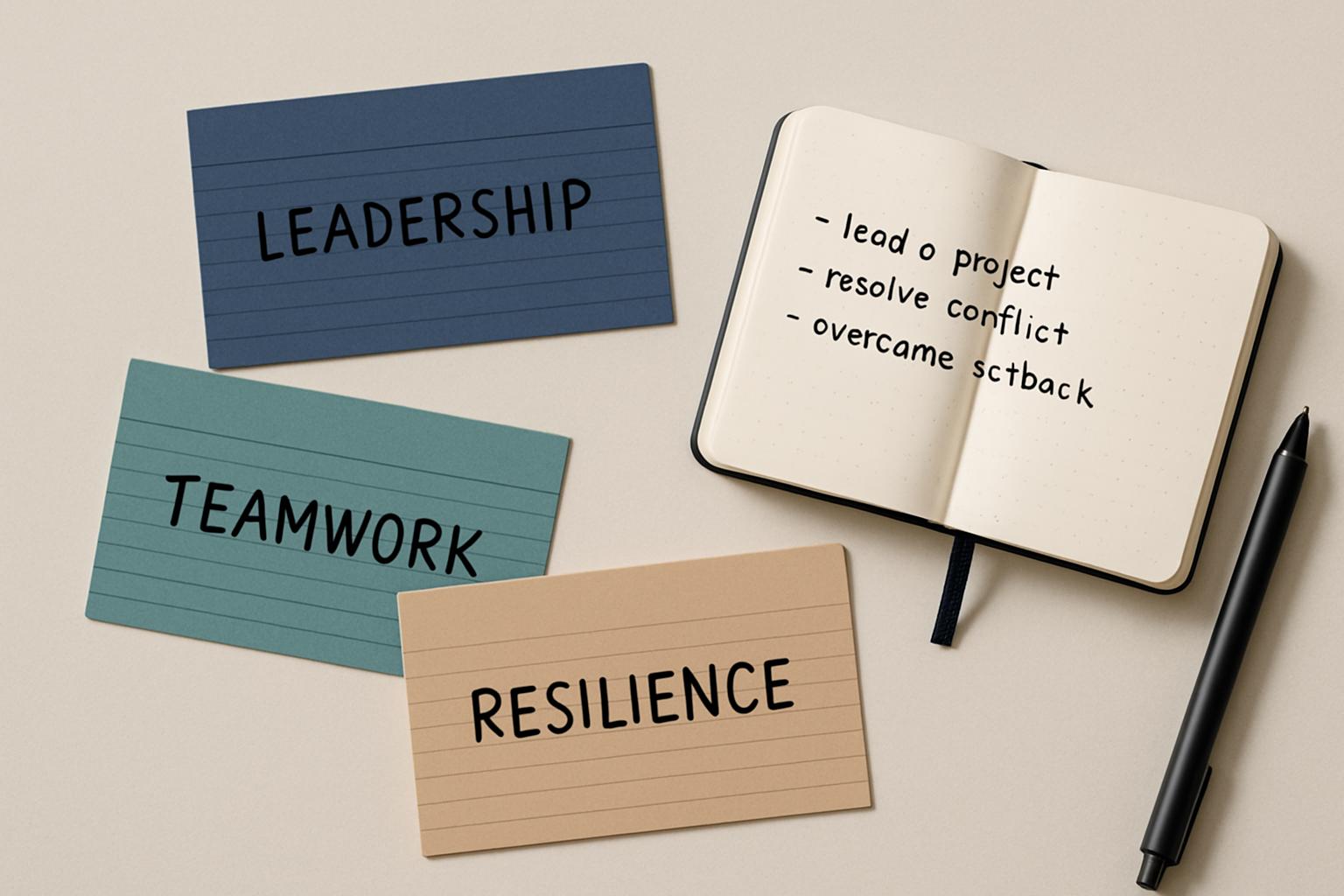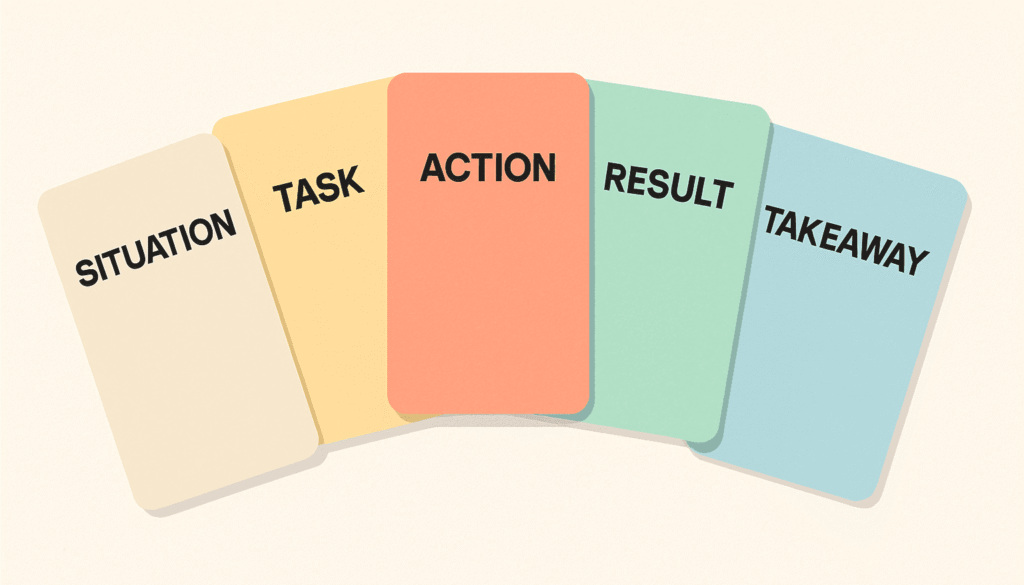Answer Any Behavioral Interview Question with STAR and Storytelling
Behavioral interview questions show up in nearly every hiring process. They are designed to reveal how you acted in past situations so an interviewer can predict how you will perform in the future. Whether your role is highly technical or client-facing, interviewers want to see concrete evidence of qualities such as leadership, teamwork, and integrity.
Short answers rarely convince. Stories do.
This article outlines a practical method for preparing and delivering behavioral answers that are concise, memorable, and convincing.
What is a behavioral interview question
A behavioral interview question asks you to describe an experience that demonstrates a particular quality. On the surface, it might sound simple: “Tell me about a time you showed leadership.” But the interviewer seeks more than a single event. They want context, specific actions, and clear outcomes that reveal how you think and operate.
Questions are framed in many ways, but most of them target the same set of work-related qualities. If you can map your experiences to those core themes, you’ll be prepared for most behavioral prompts.
Five core qualities employers test
Leadership and initiative
Companies seek individuals who take initiative and drive projects forward. Leadership is not always a title; it often means stepping up when a task needs direction or organizing a group without formal authority.
A candidate who shows initiative describes how they identified a need, proposed a solution, and mobilized others to act. The scale of the action is less important than the clarity of the decision and the follow-through.
Resilience and overcoming failure
Interviewers probe how you respond to setbacks. They are interested in process: how you learned, adapted, and improved after a failure.
Often these questions come disguised as “Tell me about your proudest accomplishment.” The point is to learn what obstacles you faced on the way to that achievement and how you overcame them.
Teamwork and collaboration
Most roles require working with others, so interviewers will assess your ability to contribute to and coordinate within teams. Basic questions ask about collaboration; deeper ones test how you resolved conflicts or aligned people with different backgrounds.
Stories that show listening, compromise, and role clarity work well here. Showing how you brought together diverse perspectives is particularly persuasive.
Influence and persuasion
Being able to influence peers and seniors is a separate but related skill. Employers want to know how you make a convincing case, backed by evidence or reasoning, and how you handle resistance.
A strong example shows how you tailored your message, anticipated objections, and used facts or logic to shift opinion.
Ethics and integrity
Questions about ethical dilemmas evaluate your judgment and values. Interviewers want to see that you act responsibly in ambiguous or sensitive situations.
Good stories demonstrate thoughtfulness: how you identified the issue, consulted the right people and arrived at an outcome that reflected your principles.
Preparing your interview stories

Conducting a brain dump to collect experiences
Start by listing every relevant experience you can recall—work projects, volunteer roles, academic activities, and even small events from daily life. The goal is quantity, not polish.
Write down brief notes about each situation: what happened, who was involved, what you did, and the outcome. Don’t censor yourself. Small moments can make excellent stories when presented in the proper context.
Building multiple stories for each quality
Aim to have at least two stories for every major quality. One example may cover leadership and influence simultaneously; another might show teamwork and resilience.
Multiple stories reduce the risk of being asked for a second example and running out of material. They also allow you to select the most relevant story for the role or interviewer.
Crafting responses with STAR
Situation and Task
Begin with two clear sentences: the situation and the specific task. Maintain this setup for approximately 10–20 seconds when speaking. Provide enough context to make the rest of the story meaningful, but avoid long background passages.
A concise setup helps the listener understand the stakes and constraints.
Action and Result
Focus most of your time on the actions you took. Describe specific steps, tools used, or communication strategies. Quantify results if possible. Numbers make outcomes tangible: time saved, percentage improvement, or revenue impact.
End the story with a clear result that ties back to the quality you intended to demonstrate.
Closing with a learning takeaway
Finish with a short reflection: what you learned and how it changed your approach. This ties the story together and shows growth. It also signals that you are reflective and continuously improving.
One crisp sentence is often enough.
Show versus tell in storytelling
Using vivid details instead of flat statements
Rather than saying “I am a leader,” show it. Describe a moment that reveals leadership: who you rallied, how you delegated, and what you prioritized under pressure. Small, sensory details make a story feel authentic and credible.
Example: Instead of “I received tough feedback,” say “my manager clipped my first draft and told me the analysis missed the core customer metric.” That paints a picture.
Making stories relevant and memorable
Select details that matter to the role. If the job values client management, emphasize negotiation and stakeholder alignment. If speed and precision matter, highlight deadlines and error reduction.
Keep one- or two-line hooks ready to open each story—this helps the interviewer stay engaged.
Practicing delivery to sound natural
Use bullet prompts, not complete scripts
Write bullet-point prompts for each story instead of memorizing whole paragraphs. Use four or five cues: situation, task, key action, result, and takeaway. Practicing from bullets forces you to form natural sentences on the fly.
This reduces the risk of sounding rehearsed.
Record and review your practice sessions
Record yourself and watch the playback. Notice eye contact, pacing, and body language. Listening back reveals filler words and awkward phrasing that you might miss in the moment.
Minor adjustments go a long way to improving presence.
Remove filler words and use strategic pauses
Filler words dilute impact. Replace “um” and “like” with short pauses. Pauses give you time to think and convey confidence. A thoughtful pause often reads as competence, not hesitation.
Short sentences can help eliminate unnecessary words.
Sample stories to model
Pitchbook example for influencing senior leaders
Situation: A managing director suggested canceling an expensive subscription.
Task: Convince leadership to retain the tool.
Action: Surveyed the analyst team, aggregated usage data, and presented results.
Result: The subscription was renewed after leadership reviewed the evidence.
Takeaway: Data-backed arguments can persuade decision-makers who need concrete proof.
Orchestra example for resilience
Situation: Missed selection for the top orchestra.
Task: Find another route to achieve the goal.
Action: Learned a new instrument, took lessons, and reauditioned.
Result: Accepted into the ensemble and toured internationally.
Takeaway: A setback can be a pivot if you stay open and work hard.
UPS example for integrity
Situation: Observed a coworker falsifying time records.
Task: Decide whether and how to raise the issue.
Action: Spoke privately with a manager, framed the concern as a process improvement.
Result: The manager addressed the issue, and the company subsequently upgraded its timekeeping system.
Takeaway: Small ethical choices shape one’s reputation and the systems within which they operate.
Final checklist before the interview
– Conduct a brain dump and select two stories per core quality.
– Convert each story into STAR bullets: Situation, Task, Action, Result, Takeaway.
– Practice aloud from bullet prompts and record at least three runs.
– Time your stories so each fits a 2–3 minute window.
– Remove common filler words; rehearse comfortable pauses.
– Match examples to the role’s priorities.
Short and focused prep beats last-minute memorization.
Conclusion and actionable next steps
Behavioral interviews reward clear thinking and practiced delivery. Collect many experiences, craft them into STAR-format stories, and rehearse from bullets until your delivery feels natural. Use vivid details and end each story with a concise learning point.
Take action today: do a brain dump, pick two stories per skill, and record one practice session. Apply minor improvements after each review, and your confidence will grow measurably.
Thank you for visiting Your Career Place. Here are some more articles to review.
https://yourcareerplace.com/behavioral-interview-questions/
https://yourcareerplace.com/top-10-answers-to-interview-questions/
https://yourcareerplace.com/how-to-write-a-cover-letter-for-a-career-change/



